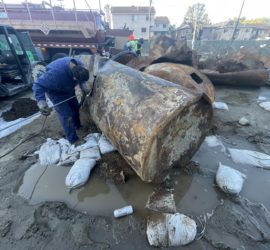C8 Water Pollution & PFAS Groundwater Contamination
The worldwide concern about C8 water pollution and PFAS groundwater contamination is a troubling matter in the scientific community today. This eight carbon-chain chemical structure goes by the name “C8” and is particularly problematic in environments, internationally. The chemical group includes perfluorooctanoic acid (PFOA) and perfluorooctane sulfonate (PFOS), which are long-chain perfluoroalkyl and polyfluoroalkyl substances (PFAS). In fact, the USEPA classifies PFAS as an emerging contaminant that is particularly troublesome because it is very stable, and hardly breaks down within the lifespan of a human. Additionally, it is highly mobile and easily transferable from the source of contamination to the end-point. For example, C8 can migrate from firefighting foam on the ground, through the soil, and into aquifers with drinking water wells. Updated January 10, 2020.
From Manufacturing to Drinking Water
In order to enter the environment, there must be an initial release of C8 chemicals. C8 water pollution and C8 groundwater contamination all starts with the manufacturing of C8, and the production and use of PFAS containing products. In an industrial plant where C8 is being manufactured (or a factory where C-8 exists to make final products), there is always waste comprising various chemicals of concern. And in these cases, the resulting waste can be in liquid or solid phase, or both. For instance, in the cutting of non-stick surfaces, cutting-dusts, liquid-lubricants, and sludge are produced. Since the 1950s (and up until the year 2016), regulatory oversight procedures for PFAS contamination have been lax. As a result, C8 waste disposal was mostly unregulated and reportedly unknown to government agencies.
How Does C8 Get Into the Soil?
As a result of the lax to non-existing regulatory standards, most liquid phase waste containing C8 was reportedly discharged directly into surface water channels, industry-wide. In such cases, C8 water pollution can flow downstream and percolate into the underlying soil formations. Alternatively, other C8 wastes, such as solids, were reportedly disposed of by landfilling or incineration. Many landfilling sites were unaware of C8 and unprepared to contain the substance. This resulted in its widespread release into the subsurface. And during incineration processes, most solid particles were ejected into the air without filtration. Consequently, the solids eventually settled back onto the surrounding soils and surface waters. Nonetheless, even when hazardous waste undergoes the seemingly-appropriate disposal procedures of the time, PFAS pollution and C8 groundwater contamination can still occur.
Soil Excavation with C8
In dealing with soils comprising C8 contamination, extraordinary precautions for handling and disposal are likely the requirement. Often times, a Soil Management Plan is in place to outline the process. For instance, an excavation manual will explain the process by which on-site workers should handle the cuttings with contamination, and how or where to dispose of it. Ultimately, this is to ensure the safety of the workers, as well as the general public during environmental remediation by excavation projects.
How Does C-8 Get Into Ground Water?
The by-products of the C-8 manufacturing processes, as well as the use of C8-containing goods, plays a major role in the PFAS groundwater contamination problem. Especially in the areas where C8 exposure occurs directly. Once C8 gets into the subsurface (by means of any scenario mentioned above), it can migrate downward into the nearest underlying groundwater aquifer. And once in the aquifer system, the extent of the chemical then spreads laterally, vertically and diagonally. This is the formation of a smear zone or plume and is typically consistent with the groundwater flow direction and gradient, as well as the regional hydrogeology. Consequently, the extent of a C8 groundwater contamination plume can conflict with the radius of influence of a municipal drinking water supply well.
From Groundwater to Drinking Water
Groundwater pumping wells comprise verticle casings that have intermittently perforated sections within saturated zones. Engineers and geologists collect hydrogeologic data within the aquifer and perform a variety of soil mechanics and hydraulic tests in order to determine the final screening intervals. Ultimately, these areas test to be of the highest efficiency and water quality, at the time of the groundwater well construction. And upon pumping activities, the groundwater within the aquifer is extracted from a “Zone of Influence” that surrounds the well location. In fact, the groundwater within the Zone of Influence forms a “Cone of Depression” at the theoretical groundwater-surface. As a result, all of the groundwater within this capture zone ultimately leads to the well pump, and into the municipal supply. Consequently, a comingling PFAS contamination plume results in C8 water pollution.
PFAS Surface Water Pollution
Liquid phase waste containing C8 has historically been discharged directly into surface water sources in varying quantities. The most typical receptor of this pollution is the river and stream system. For instance, the Ohio River received large injections of C8 waste flowing from the West Virginia areas. And the C8 water pollution that occurred in the upgradient West Virginia locations subsequently contaminated the downstream sites such as Southern Ohio and beyond. Once flowing within surface water, C8 can move into the underlying soil and eventually groundwater.
Controlled C8 Water Discharges
To date, records do not clearly indicate exactly how much C8 has been discharged in this way. Nonetheless, it is widely known at this time that numerous industrial operations produce this waste, and must dispose of it somehow. Permits are available through the National Pollutant Discharge Elimination System (NPDES) which allows companies to dispose of known and controlled quantities of certain contaminants. This applies to unavoidable waste generation.
Pollution from Landfills
Another common receptacle for C8-waste contamination is the landfill system. Although modern standards require protective linings under landfill sites, C8 water pollution still occurs from disposing of PFAS waste. In a 2017 study by Lang et al., the groundwater around landfills contained concentrations of C8 chemicals at levels over 3,500 parts per trillion (ppt). In fact, this concentration is 50 times greater than the recent EPA health advisory level. This study provides a clearer picture of how C8 can migrate from a landfill site, into the subsurface, and eventually groundwater.
Wastewater
When a wastewater treatment facility accepts industrial wastewater containing C8, the plant makes an effort to remove any hazardous substances that are present in the water. However, C8 is particularly difficult to destroy and so it remains in the wastewater. From there, some of the C8 will attach to the biosolids, which are the solid parts of wastewater that will be filtered out during treatment. While some of the C8 water pollution adsorbs into this sewage sludge, the rest of it passes through the entire treatment process and is discharged into the surface water supply. From there, PFAS migrates through the abovementioned pathways and eventually results in C8 groundwater contamination.
Alternative Wastewater Sludge Treatment
Alternately, the biosolids from wastewater (now contaminated with C8), can be deposited either into a landfill or applied to the ground surface as an agricultural fertilizer. Whether buried in a landfill or applied to the surface soil, the PFAS contamination will ultimately find its way into the groundwater.
Atmosphere
An alternative to processing C8 by-products as a liquid is to incinerate the waste. This method is more expensive to the manufacturer than to discharge the waste directly. Although it is attractive because it creates a “non-point source” of pollution. A non-point source is diffused and not attributed to a heavy concentration of pollution coming from one specific area, which constitutes a “point source.” This non-point pollution is achievable when the C8-containing waste burns and the subsequent smoke, fumes, and ash spread high and wide into the atmosphere. In doing so, the ash becomes lesser in concentration as the plume disperses the pollution over an expanding area.
What Goes Up Must Come Down
However, as the old saying goes, what goes up must come down. And in this case, all the C8 in the air eventually settles onto the soil and surface water. Similarly, with the other methods of disposal, the C8 will end up in the groundwater, and contribute to the C8 water contamination problem.
C8-Containing Products
In addition to C8 water pollution by manufacturing, the use of final products can also lead to PFAS groundwater contamination. Perhaps the best example of a product that impacts the environment is C8-containing fire foam. Professionals refer to this product as aqueous film-forming foam or AFFF, and it contains the PFAS chemicals PFOS and PFOA. The material applies to military and civilian firefighter activities, in order to put out fuel fires, not subduable by water. In fact, firefighters also use this foam as a precautionary measure onto areas of fuel spillage. This is to preemptively combat the potential for the fuel to combust. For example, if a truck transporting diesel fuel crashes and spills fuel on the freeway, firefighters apply massive volumes of AFFF right away. Consequently, the application of C8-containing foam onto the ground surface ultimately leaches, resulting in PFAS groundwater contamination.
C8 in Groundwater
Groundwater makes up a significant percentage of the earth’s water and is a vital natural resource. Regarding groundwater, C8 water contamination is concerning because the substance can end up within capture zones of pumping wells. And in such cases, the contaminant does not simply stay underground to degrade. Instead, it resurfaces and transports onto other media by mode of irrigation and drinking water consumption. Shallow, intermediate, and deep wells are a source of water for public, private, agricultural, and industrial water supplies. Humans are dependent on clean groundwater as it serves people directly. And groundwater quality also plays an important role in the ecosystem balance of the planet.
PFAS Groundwater Consumption
According to the National Ground Water Association (NGWA), 44 percent of the United States population depends on groundwater for its drinking water supply. This includes 33 million Californians who pump roughly 10.7 billion gallons per day (as of the year 2019) of groundwater for all purposes. California pumps more groundwater than any other state. The most common way to utilize groundwater for municipal drinking water purposes is with an extraction well. This is process comprises drilling multiple pilot boreholes to scientifically test aquifer efficiency and installing a casing that extends into the optimal sections of an aquifer. A custom pump then draws the groundwater from the aquifer for distribution. And a considerable amount of maintenance and water quality testing must occur as the operations continue.
Ground Water Monitoring
The EPA established a “health advisory level” (HAL) for C8 in 2016. Accordingly, the National Ground Water Association (NGWA) encourages routine testing for contamination within active production wells, to ensure drinking water supplies remain below the 70 parts per trillion (as of the year 2019). Although testing for PFAS groundwater contamination is complex, there are resources that can utilize the EPA requirement for testing via Method 537. In fact, there are plenty of laboratories across the United States, that are capable of performing C8 groundwater contamination testing in accordance with EPA standards.
C8 Water Testing & Drinking Water Quality
Based on EPA’s sampling of water supplies across the country, as many as 15 million people live in areas where PFAS concentrations are above the HAL. This includes PFAS groundwater contamination. And because it takes such a long time for C8 levels to decline in the environment and in our bodies, it is important to stay mindful of this exposure. The latest and ongoing scientific research will inform industries and individuals as to the best course of action for the future of the C8 water pollution issue.
Authors:
Written By: Michael J. Sabo
Co-Written & Edited By: Adam A. Kaligi, PG
Sources:
The State of Michigan:
https://www.michigan.gov/documents/pfasresponse/Science_Advisory_Board_Report_641294_7.pdf
Wisconsin Department of Natural Resources:
https://dnr.wi.gov/topic/Groundwater/
U.S. Department of Defense:
Environmental Protection Agency:
https://www.epa.gov/nutrientpollution/where-occurs-ground-water-and-drinking-water
Minnesota Rural Water Association:
https://www.mrwa.com/SWP/Brochures/WellManagementBrochureMRWAWeb.pdf
CA State Water Resources Control Board:
https://www.waterboards.ca.gov/water_issues/programs/groundwater/gw_basics.html
National Groundwater Association:
https://www.ngwa.org/publications-and-news/journals/groundwater-monitoring-remediation


